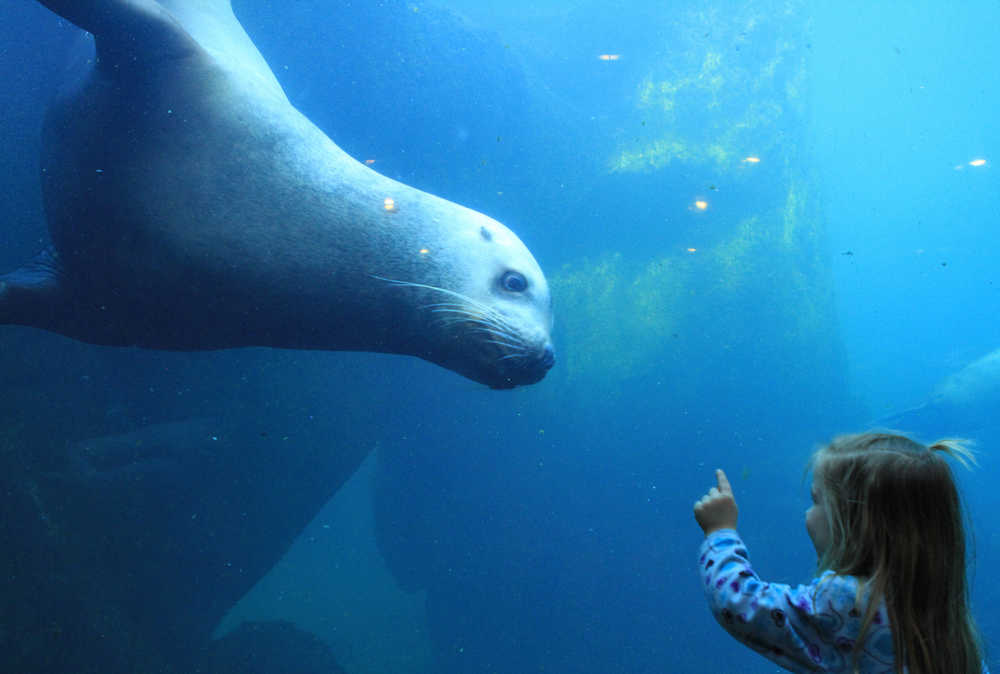ANCHORAGE — Thousands of people visit the Alaska SeaLife Center in Seward for a look at Steller sea lions or harlequin ducks.
What’s in the basement is almost as interesting.
The SeaLife Center, which combines aquariums with research and wildlife rescue, announced Friday that 98 percent of its heating and cooling requirements are no longer filled by fossil fuel. The center is using alternative energy: heat extracted from ocean water in Resurrection Bay.
The heat exchange system is saving money, cutting greenhouse gas emissions and fulfilling the center’s mission of sharing scientific knowledge to promote stewardship of Alaska’s marine resources, said Darryl Schaefermeyer, special projects coordinator. It demonstrates that seawater is a potential heating source for Alaska, which has more coastline than the rest of the nation put together.
“Simple payback is estimated to be 13 years at the estimated annual savings on electricity of $48,000,” he said. “Since starting the system, we have averaged just over $4,000 savings on electrical energy cost per month.”
It’s used with a seawater system the SeaLife Center installed in 2012.
The new system was designed by Andy Baker of YourCleanEnergy, an Anchorage consulting firm. It uses equipment manufactured by a Japanese firm, Mayekawa, and relies on a complex system of pipes to heat some parts of the building and cool others.
“The trick is to getting all those loops to transfer heat at the correct rate,” Baker said.
Resurrection Bay, at more than 900 feet deep, absorbs solar heat over summer months. The water warms through late October, and below the surface, retains enormous amounts of heat throughout winter.
Heat exchangers are devices that transfer heat from one loop of liquid to another without mixing the liquids.
The center’s new system draws seawater at 42 degrees or higher from 300 feet deep and pumps it into a heat exchanger with non-corrosive titanium plates, where it heats a loop of water and 10 percent glycol, an antifreeze.
The warmed water and glycol loop is passed alongside a loop of liquid carbon dioxide, causing the liquid CO2 to boil into a vapor.
A compressor squeezes the vapor, increasing its pressure up to 2,000 psi, which raises the vapor temperature dramatically from 100 to 194 degrees.
The heated CO2 vapor is exposed to yet another loop: the water that circulates through the SeaLife Center’s building. It can heat 100-degree water to 194 degrees. The system blends 194-degree water with cooler water to send 160-degree water circulating through conventional baseboard heaters in office and lab space.
The system has been operating since Jan. 21. On Seward’s coldest nights, about 2 percent of the time, the center had to turn on an electrical boiler for more heat.
The first seawater system, which cost about $1 million, came on line in December 2012. Instead of carbon dioxide, it uses a synthetic refrigerant that can be heated to about 130 degrees, Baker said. It’s used to heat the center’s air-handling units and outdoor pavement and to preheat hot water.
Grants helped pay for the new system, including a $537,640 emerging energy technology grant from the Alaska Energy Authority. The Rasmusson Foundation kicked in $50,000, and the center spent $68,000 on in-house labor.
Besides cutting its heating bill by more than half, the center estimates it has reduced its annual carbon emissions by 1.24 million pounds.
Baker anticipates the technology will expand to other large energy users. The cost likely will come down as competitors emerge.
“They’re not ready to stick into a home or small business,” Baker said of the seawater heat exchange system. “They’re going to be a little too expensive and too complex. Eventually it will get there.”

